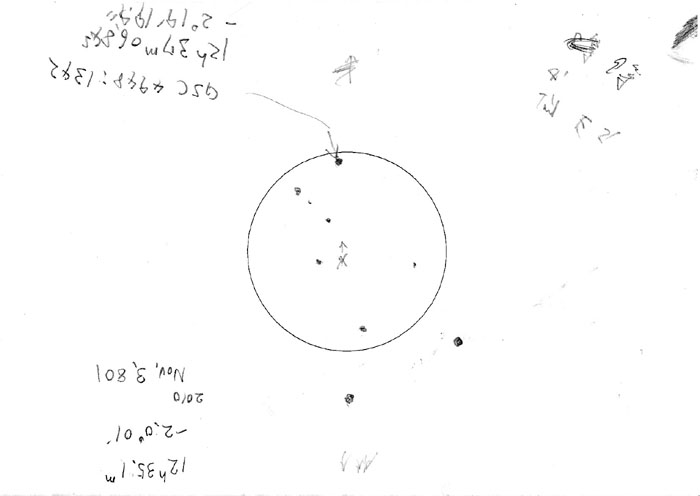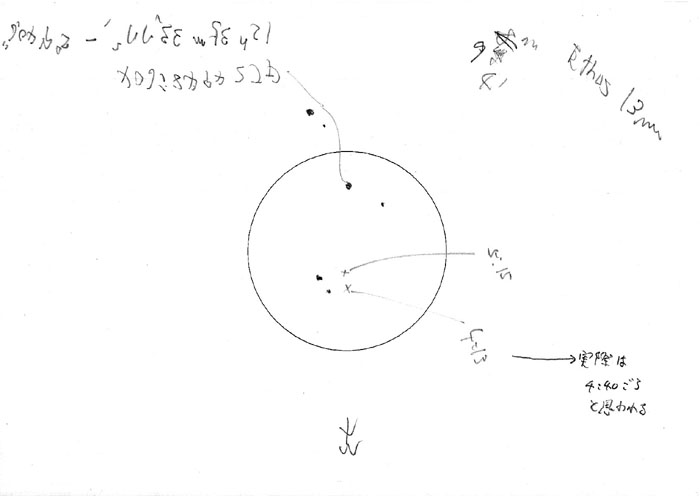
Discovery story: Final version
P/ 2010 V1 Ikeya-Murakami
Posted on November 27, 2010
by Shigeki Murakami
Longing for Leo
I comet hunted at dusk on October 27, and since then it had been cloudy and rainy. When it comes to comet searching sessions at predawn, more than two weeks had passed since I conducted the last one on October 19. I have been longing for searching in the constellation of Leo in October, as publications of Tsutomu Seki read that new comets have been often discovered in this constellation, but I could not comet hunt in Leo at all in October due to nasty weather.
Actually, I discovered a possible new comet at predawn on October 4 Japan Standard Time (JST) in 2006and I made a phone call to the National Astronomical Observatory of Japan to leave a message on the answering machine from my observing site. Nevertheless, when I got back home and turned on my PC I learned the comet had already been posted on the NEO Confirmation Page and announced as C/2006 T1 Levy. In the era of the Internet this could happen.
Letüfs get back to the present discovery. On November 4 JST, 2010, the sky was crystal clear at last. I got up at 2a.m. and changed my clothes. I drove to the usual observing site and arrived there at around 2:30a.m. As soon as I got there I decided to search in the constellation of Leo, because I was still attracted by this constellation even in November. I set up my 46 cm comet-seeker and enjoyed observing 103P Hartley prior to a comet hunting session.
At 3:10a.m. I trained my comet-seeker at a few degrees west of Regulus, alpha Leonis, and then, as usual I aimed my comet-seeker at an altitude of some 40 degrees above the horizon, and began to sweep the sky downward. When the field of my comet-seeker reaches the horizon, I move the telescope northward horizontally overlapping the field of view (FOV) about 3/4 to 2/3, and train the comet-seeker at an altitude of around 40 degrees again to sweep the star field downward. The overlap of the FOV must be large enough or I will overlook some part of the sweeping area. I always sweep from the higher part of the sky to the lower, otherwise my arm gets tired.
I identified 13 galaxies in the attractive constellation of Leo, NGC3041, 3640, M95, M96, 3338, M105, 3384, 3389, 3367, 3377, 3412, 3487, and 3705 with the magnitudes of 9th to 13th. They were easily identified using digital setting circles, NGC Sky Vector, Lumicon. After one hour from the beginning of the hunting session, a large and bright galaxy with a bright nucleus came into the FOV. The position was not in Leo but Virgo. I wondered if there was such a galaxy around this area. I tried to identify this galaxy using digital setting circles, but there were no candidates. The NGC Sky Vector does not work well when it is low battery and I checked if it functioned by moving my comet-seeker. It worked well. I used the üeSearch Modeüf of this device again but the result was the same! At this moment I judged this object as a new comet: it took less than one minute to make a judgment. It was 4:13a.m. My heart started beating and tension run high. I made a note of the Right Ascension and the Right Declination displayed on the NCG Sky Vector. All I had to do as the next step was to plot the position on the star atlas (Uranometria 2000) for precise positioning at home.
Near Saturn again
Leo stood up on the eastern sky majestically on his hind legs. I peered into the eyepiece and noticed that the FOV got brighter. The crescent moon with earthlight rose only 7 degrees south of the new comet. At the same time I noticed that a bright star a few degrees away from the comet rose from the horizon. I saw it was Gamma Virginis, Porrima, as it was just below the position of M65 and M66. How lucky I was! I thought it must be easy to determine the position of the new comet.
Contrary to my optimistic prospect, I had a hard time to determine the position on the star atlas, Uranometria 2000, because the asterism in the FOV of the 50 mm erect finder never coincided with that of the map. Whatüfs happened? Was this a dream? I had no idea. Then, a fireball with a magnitude of -5 fell down with sparks on the northeastern sky as if it had celebrated my discovery!
I
guessed more than 5 minutes had passed when I became aware of Porrima getting
brighter strangely. The star seemed to speak to me and I aimed my comet-seeker
at Porrima. That solved the mystery! The star was not Porrima but Saturn! This
misunderstanding happened because Saturn looked darker at the lower altitude (5
degrees) and looked like the 3rd magnitude star, Porrima. On top of
that I have not conducted comet hunting session for over two weeks at predawn,
and could not realize that Saturn was there. The actual Porrima was 1.5 degrees
upward of Saturn and the distance between Saturn and the comet was only 3
degrees. As the same with the üediscoveryüf in 2006 I have discovered a possible
new comet near Saturn! I felt a relief when I saw Saturn. I could manage to
determine the position of the comet on the map and drew a sketch to determine
more precise position of the comet. I verified RA and RD again and again to see
if they were correct.

Sketch 1
The first sketch upon discovery. A ügxüh mark at the center shows the position of the discovery. The upward arrow is the direction of the motion. The west is downward. 46 cm 78x, FOV= 1.1 deg.
Discovery report
I was ready to report my discovery using a mobile phone. I wondered where I should call. I remembered that Syuichi Nakano, an Associate of Central Bureau of Astronomical Telegram (CBAT) was not at his office when I made phone call upon the discovery of C/2002 E2 and C/2006 T1. For this reason, first of all, I called the National Astronomical Observatory of Japan (NAOJ) at 4:31a.m. to leave a message on the answering machine. This was a proof that I discovered the comet at this moment at the latest. Next, I phoned Nakano. I guessed the comet had already been discovered as it was bright. He picked up my call in a second (4:33a.m. JST). I told him ügIüfm Shigeki Murakami, Tohkamachi Niigata-ken. I spotted a possible new comet.üh He answered ügWow!üh I learned that the comet had not yet been discovered. I informed him of the following data:
The preliminary data at the site:
2010 Nov. 4, 4:13a.m. (JST), RA 12h 35m,
RD -1.9 deg., mag.=9, coma diameter= 4'
He asked me if there was a tail but I replied I did not notice the tail. I said, ügYou think someone can confirm the comet at home, canüft you?üh He told me he would ask someone to confirm the possible comet.
I was
able to breathe again, and continued observation to check the motion of the
comet. I multiplied the magnification of an eyepiece to 157x and confirmed the
motion eastward as shown Sketch 1 and 2. I also noticed that the comet had a
short and wide tail directed to the east (position angle= 90 deg.). Later the
tail developed westward but what I observed upon discovery differed from this
westward tail (cf. this page). I called
Nakano again to let him know the motion and the tail at 5:08a.m. He said that he
contacted Koichi Itagaki, Yamagata, Japan, and that Itagaki headed for his
observatory to confirm the comet. At 5:15a.m. the comet disappeared in the
twilight. I took down my comet-seeker and drove to my home. I tried to drive
safely without hassles. While I was driving I thought the comet might be
periodic because it was near Saturn.

Sketch 2
The second sketch upon discovery. Two ügxüh marks represent the positions at around 4:40a.m. and 5:15a.m., respectively. The west is downward. 46 cm 157x, FOV= 38üf.
Discovery by Ikeya
I got back home before 6a.m. I turned on my PC to check emails. To my surprise Itagaki had already confirmed the comet and his data along with mine had been sent to CBAT by Nakano. The first email sent to CBAT from Nakano had the timestamp of 4:39a.m. and the second one including the confirmation data by Itagaki was 5:29a.m. The comet was also posted on the NEO Confirmation Page. It was astonishing that everything had been completed less than one hour. I thank Nakano and Itagaki earnestly. All I could do was to wait for the process in CBAT. I left a message on the answering machine in NAOJ to tell them that the comet had been confirmed and the data was sent to CBAT. I received an email of congratulations with the photo of the comet from Itagaki. I felt relieved the comet was confirmed quickly and surprised at the speed of the processes.
At 7:40a.m. I received a surprise email from Nakano that read Kaoru Ikeya had discovered the comet on November 3 JST, one day before my discovery! The email was sent to CBAT and Itagaki too. There seemed to be a trouble concerning a conveyance of information or Ikeya would be an only discoverer of the comet.
I forget to send a precise position of the comet. At home I finalized the position using the digital map (MegaStar ver. 5) and sent it to Nakano with other data:
2010 Nov. 3.801 UT, 12h 35m.1, -02 01',
mag.=9, coma diameter= 4' , tail
length= 2', position angle= 90 degrees
(east), motion= east 2'/ hour
Conclusions
This comet was named as C/2010 V1 Ikeya-Murakami, and later it turned out to be a periodic comet. Not to mention greatness of Ikeya, I was really inspired by him. I was encouraged by his discovery of 153P Ikeya-Zhang on my birthday that led me to my first discovery of C/2002 E2 Snyder-Murakami. It is my great honor the comet was co-discovered with Ikeya, but at the same time I cannot help feeling something weighty.
Tsutomu Seki had pointed out that the visual discoveries were possible under the era of robotic survey. I myself conducted an investigation on this issue and announced the result. I have kept searching since I thought I should not stop comet hunting with plausible reasons. But now, I simply love to sweep the night sky than ever before irrespective of the robotic survey. This may explain why I have kept searching, though I have felt that I would not discover new comets anymore throughout my life.
I paid
attention to Leo thanks to Tsutomu Seki. I have been able to keep searching
owing to Kaoru Ikeya. I feel this discovery like a reward given by them. Also,
it looks like a second coming of the discovery of C/2006 Levy where I spotted
the comet near Saturn and it is a periodic comet. I wonder if this is a
coincidence.
Back to Discovery
page
Back to
home